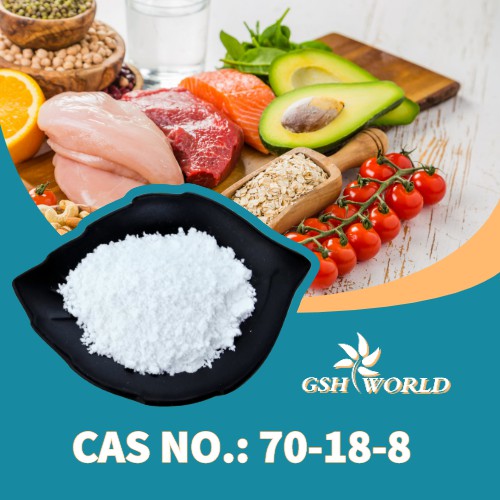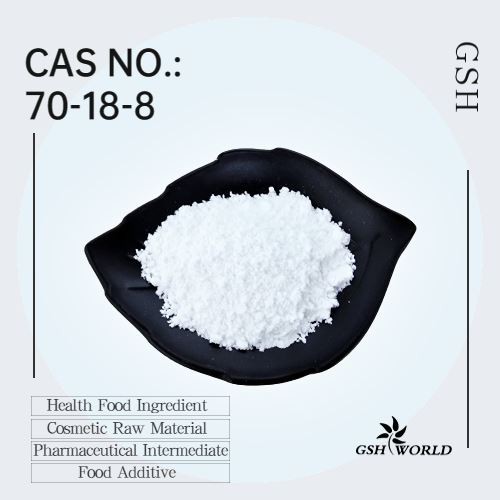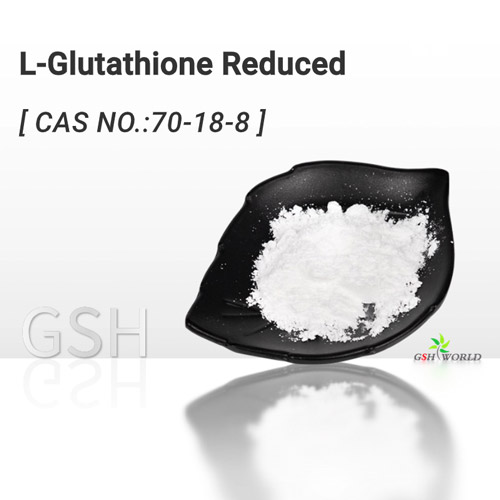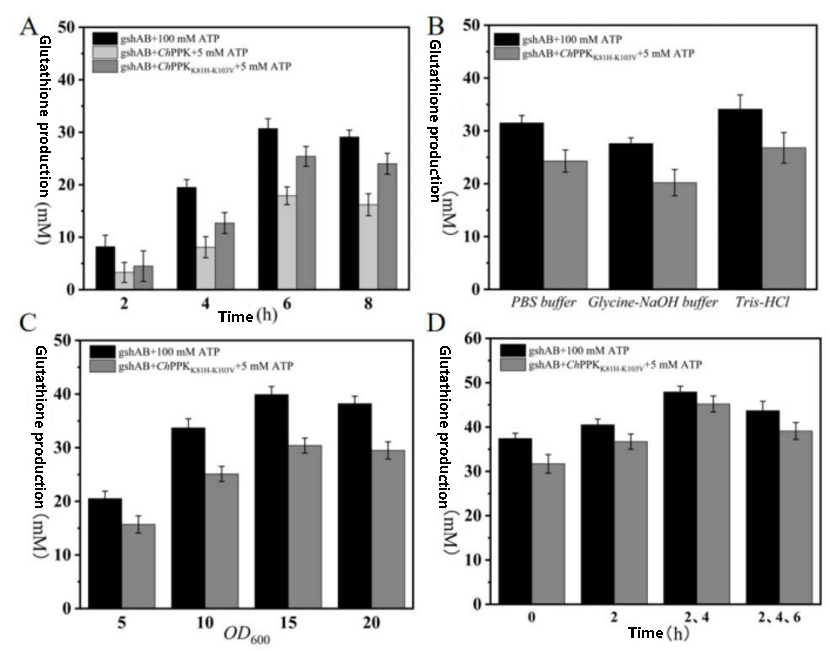Glutathione is a tripeptide compound (gamma-glutamyl-L-cysteinyl-l-glycine) that combines glutamic acid, cysteine, and glycine.
The structure of glutathione contains an active sulfhydryl -SH which is easily dehydrogenated by oxidation, and this specific structure makes it the main free radical scavenger in the body.
As an important antioxidant and free radical scavenger in the body, it can be combined with free radicals, heavy metals, etc., thereby transforming harmful poisons in the body into harmless substances and excreting out of the body.
The study found that when oxidative stress is present in the human body, glutathione can play a protective role through two pathways:
(1) Direct removal of free radicals: skin is stimulated by ultraviolet rays, pollutants and other external environment, will produce free radicals and other harmful substances, resulting in oxidative damage, glutathione can react with free radicals and other harmful substances, convert them into harmless substances, and protect cells from oxidative damage;
(2) Indirectly involved in antioxidant processes: Glutathione can work with other antioxidants such as vitamin C, vitamin E, etc., to enhance their antioxidant capacity and protect cells from oxidative damage. It plays an irreplaceable role in maintaining cell health and the proper functioning of the immune system.
Glutathione health benefits
1. Antioxidant effect
Glutathione is through sulfhydryl group and free radical combination, thereby accelerating free radical excretion, GSH (china glutathione manufacturers) as an important antioxidant in the body, can remove free radicals in the human body.

Because GSH itself is susceptible to oxidation by some substances, it can protect the sulfhydryl groups in many proteins and enzymes in the body from oxidation by harmful substances, so as to ensure the normal physiological functions of proteins and enzymes.
Glutathione and lipoic acid combined with free radicals through sulfhydryl structure, thus accelerating the excretion of free radicals, and the effect is better with VC and VE.
2. Broad-spectrum detoxification
The sulfhydryl group on GSH can combine with toxic compounds, heavy metal ions or carcinogens that enter the human body, and promote their discharge from the body to play a neutralizing and detoxification role.
Although glutathione is present in every cell, the concentration in liver cells is 7 to 10 times higher than elsewhere.
The first stage of liver detoxification to change the toxic substances into more toxic intermediates, and the second stage to change the intermediates into non-toxic water-soluble substances that excreted through the urine.
Glutathione acts in the second stage, speeding up the metabolism of toxic substances.
3. Support energy metabolism
As an important metabolic substance in cells, GSH is not only a cogroup of glyceraldehyde-phosphate dehydrogenase, but also a coenzyme of glyoxalase and triose dehydrogenase. It participates in the tricarboxylic acid cycle and sugar metabolism in vivo, and can activate a variety of enzymes to promote the metabolism of sugars, fats and proteins.
When mitochondria produce energy, they also produce many free radicals, which, if not eliminated in time, will also cause damage to mitochondrial function, thereby affecting energy metabolism.
Therefore, the characteristics of GSH to remove free radicals also have the function of protecting mitochondria and protecting energy metabolism.
Glutathione regulatory dynamics

In the 1920s, glutathione was studied abroad and has widely used in various fields of food processing.
The application of glutathione in food in China is mainly used to inhibit Browning, prolong food storage period, and increase food flavor.
Glutathione is a “Generally recognized Substance for Safe Use” (GRAS) published by the FDA, and the determination of “GRAS” is made by the food industry based on relevant laws and regulations, public scientific evidence or long-term history of use, and careful evaluation of its safety under specific conditions of use.
In the GRAS declaration of glutathione on the FDA website, the recommended dosage of glutathione in food, beverages, pastries, confectionery products is 0.004-0.667%.
Glutathione yeast extract a food, which meets the national standard “GB/T23530 yeast extract”, and added to food according to the production demand as a yeast extract.
In the ingredient list can labeled as yeast extract, advertised as glutathione content.
In addition, glutathione yeast extract has widely used in powder, liquid, tablet, gummy and other dosage forms. The stability of solid dosage form is better than that of liquid dosage form.
Glutathione yeast extract has good solubility in water, fast dissolution rate, and the solution is clear and transparent.
Food antioxidants such as vitamin C can appropriately added to the liquid dosage form to reduce the loss of glutathione during preservation.
Glutathione production technology
Glutathione (GSH) the most abundant non-protein mercaptan compound of all living things, has antioxidant, antidote and immune booster capabilities, and widely used in the medical, food and cosmetic industries.

Recently, a glutathione bifokinase (GshAB) has found in Streptococcus agalactis, which can directly catalyze the synthesis of GSH from the precursors glutamate, cysteine and glycine, accompanied by the consumption of two molecules of ATP.
Glutathione production by fermentation may have problems such as membrane barrier, substrate restriction and product transport, while whole-cell catalysis requires the addition of a large amount of ATP, resulting in high cost.
Adenosine triphosphate (ATP) is an essential high-energy phosphate compound in living organisms, which provides energy for the synthesis, transportation, and information transfer processes in living cells.
In enzyme catalysis, ATP often acts as a cofactor of group transfer and involved in the production of high-value products.
In recent years, the reversible reaction of inorganic polyphosphate with ATP catalyzed by polyphosphate kinase (PPK) has attracted much attention.
The bifunctional polyphosphate kinase PPK uses cheap and readily available phosphate (polyP) as a substrate, belonging to the PPK2-ⅲ class, and can catalyze both adenosine diphosphate to adenosine diphosphate to adenosine triphosphate.
How to apply polyphosphate kinase to glutathione production and improve the yield and conversion of glutathione has become an urgent problem.
Glutathione technology content
In order to solve the above technical problems, the technology rationally designed to expand the double substrate polyP6 and ADP channel cavities of POLYPkinase through molecular docking and site-specific mutation, and improve the specific enzyme activity of polypkinase.
The screened polypkinase mutants were used for the production of glutathione.
GshAB and polyphosphates kinase produced and accumulated by fermenting bacteria.
After collecting bacteria, cells broken to get lysate, which has the advantage of endogenous ATP to start regeneration system.
To avoid the problems of cell barrier and complex pathway modification during the intracellular production of glutathione, the glutathione production pathway can quickly reconstructed in vitro.
After coupling ATP regeneration system, the use of ATP can reduced, and the production system can optimized to achieve efficient production of GSH.
Before site-specific mutation, the specific enzyme activity of ChPPK was 605±2.1 U/mg. After mutation, the double mutant enzyme ChPPKK81H‑K103V showed the highest catalytic activity, with the specific enzyme activity of 1972±2.5 U/mg.
In addition, the regeneration system of ChPPKK81H‑K103V achieves the unity of high yield, high conversion and high economic value of enzyme-catalyzed glutathione.
After obtaining the highly efficient PPK mutant enzyme, the addition of ChPPKK81H‑K103V in the biocatalactic reaction can significantly improve the efficiency and sustainability of ATP regeneration, improve the catalytic efficiency and substrate conversion rate after system optimization, and save the cost of energy-required reaction.

conclusion
Glutathione a tripeptide compound contained in all living cells and an important intermediate substance in biological metabolism.
Using glutathione as a functional active factor, it can made into different types of functional foods, such as beverages, hobbies (candy, etc.), dairy products, pasta foods, fermented foods, and oral health products designed for some special groups (such as pregnant women, infants and patients, etc.).
In addition to the food field, GSH can also widely used in many fields such as medicine, health care products and cosmetics, and it will also have great development potential in the field of biological fertilizer and feed additives in the future.

